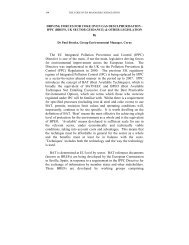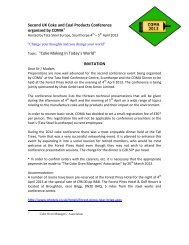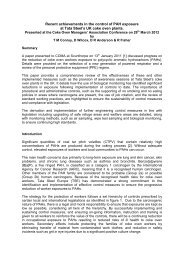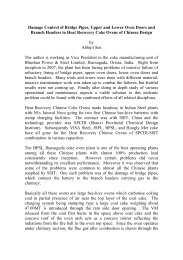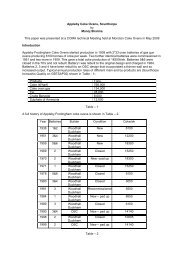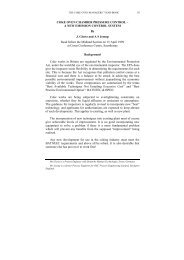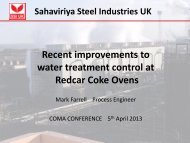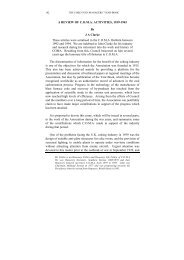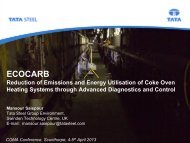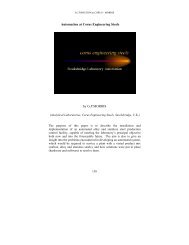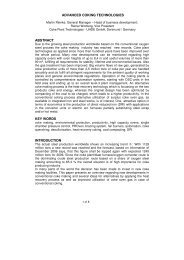CHAIRMAN'S ADDRESS - Coke Oven Managers Association
CHAIRMAN'S ADDRESS - Coke Oven Managers Association
CHAIRMAN'S ADDRESS - Coke Oven Managers Association
Create successful ePaper yourself
Turn your PDF publications into a flip-book with our unique Google optimized e-Paper software.
226. THE COKE OVEN MANAGERS’ YEAR-BOOK<br />
SIMPLEX COKE OVENS: THEIR HISTORY (PART 1)<br />
By<br />
Dr D G Edwards<br />
Introduction<br />
<strong>Coke</strong> ovens of Simplex design formed a small but significant proportion<br />
of the by-product coking plants erected in Britain in the first three decades<br />
of the twentieth century. Such plants were built at nine sites in England and<br />
two in Wales, but none in Scotland. The total number of by-product ovens<br />
constructed was 817, of which 473 were of the waste-heat type and 344<br />
were regenerative (Table 1) 1 . At five sites - Chilton, Newton Cap,<br />
Upholland, Ackton Hall and Clay Cross - Simplex ovens were the only<br />
type of by-product oven ever built.<br />
According to official figures 2 , the largest number of Simplex byproduct<br />
ovens actually in use during any calendar year was 523, in 1921.<br />
This was out of a total of 8146 by-product ovens in Britain, with Simplex<br />
ovens fifth in numerical order, after Otto-Hilgenstock (1993 ovens),<br />
Koppers and Simon-Carves (1707 each) and Semet-Solvay (1124), but<br />
ahead of Coppée (384), Huessener (379), Collin (126) and Still (72), with<br />
smaller numbers of other types making up the total. In 1938, Simplex, with<br />
375 ovens out of 5575 in use, occupied sixth place behind Otto-<br />
Hilgenstock, Simon-Carves, Koppers, Becker and Coppée.<br />
Simplex non-recovery ovens were also built at at least two sites in<br />
South Wales, evidently as an alternative to the more usual Coppée ovens:<br />
the Maritime plant had 130 such ovens by 1910 3 , and Rhymney Iron Co.<br />
had 50 built as late as 1915 4 . By 1920, only 58 of these ovens were<br />
reported 2 to be still in use, and none at all in succeeding years.<br />
Simplex ovens were also built in continental Europe. By-product plants<br />
which it has been possible to identify 5 were as follows: in Belgium, at<br />
Frameries (near Mons, installation destroyed in the Great War) and<br />
Selzaete (= present-day Zelzate near Ghent, 44 ovens started up 1926,<br />
visited by a C.O.M.A. group in 1927); in France, at Flers-en-Escrebieux<br />
(Douai, 88 ovens replacing an earlier Simplex plant destroyed in the Great<br />
War), Quiévrechain (near Valenciennes, 80 ovens) and Moyeuvre (NW of<br />
Metz, 60 ovens); and in the Netherlands, at Maastricht (90 ovens). One was<br />
Dr Edwards, now retired, was Information Officer, British Carbonization Research<br />
<strong>Association</strong>, 1962-1983 and is a freelance scientific editor.
SIMPLEX COKE OVENS: THEIR HISTORY (PART 1) - EDWARDS 227.<br />
also built at an unidentified site in Russia/Ukraine but was left<br />
uncompleted on the outbreak of war in 1914 6 . At least two non-recovery<br />
plants were also erected: at the ironworks begun in 1900 at Portoferraio on<br />
the Isle of Elba, Italy (104 ovens) 7 and at Enakievo in Ukraine (52 ovens<br />
built by 1903) 8 .<br />
County Plant NGR a<br />
Owners<br />
<strong>Oven</strong>s b<br />
Durham Chilton NZ2730 H Stobart & Co. 52 WH c<br />
Start-up<br />
date<br />
Final<br />
closure<br />
date<br />
1909 1938/9<br />
Fishburn NZ3631 H Stobart & Co. 50 R 1919 1954<br />
Lambton NZ3151 Lambton [&c.] Collieries d 35 R 1918/19 1938/9<br />
Newton Cap NZ2030 H Stobart & Co. 44 R 1914 1918 e<br />
Lancs. Upholland SD5003 Mountain Mine Colliery Co. f 35 WH c.1914 1930<br />
Yorks. Ackton Hall SE4220 Ackton Hall Colliery Co. 50 WH 1914 1939-45<br />
Hemsworth SE4115 South Kirkby [&c.] Collieries g 44 WH 1904/5 1929/30<br />
Derbys. Clay Cross SK4064 Clay Cross Co. h 34 WH 1905 c.1930<br />
16 WH 1907 c.1930<br />
23 R 1928/9 1953<br />
32 R 1932 1952<br />
Staveley SK4274 Staveley Coal & Iron Co. i 100 WH 1907 c.1922<br />
Glam. Bargoed ST1599/<br />
SO1500<br />
Powell Duffryn Steam Coal<br />
Co.<br />
Trehafod ST0390 Lewis Merthyr Consolidated<br />
Collieries<br />
100 WH 1922 1965/6<br />
70 R 1925 1966<br />
50 R 1914 1920 j<br />
50 R k 1909 1919<br />
40 WH 1919/20 1929/30<br />
a National Grid Reference of 1 km square in which the plant lay; some uncertainty remains about the NGRs for<br />
Newton Cap, Hemsworth and Bargoed. b WH = waste-heat, R = regenerative. c Originally 50, rebuilt as 52 in 1920-<br />
2. d 1910, Lambton Collieries; 1913, Lambton & Hetton Colleries; 1930, Lambton, Hetton & Joicey Collieries.<br />
e Listed in the COMA Year-Book 1917 but not thereafter, inferred from ref. 68 to be still in operation at the end of<br />
1917. f 1916, Bispham Hall Colliery Co.; 1925, Upholland Coking & By-Products Co. g South Kirkby, Hemsworth<br />
& Featherstone Colleries Ltd. h 1913, Clay Cross Iron & Coal Co.; 1929, Clay Cross Coal & Iron Co. i 1950,<br />
Staveley Iron & Chemical Co.; 1962, Stanton & Staveley. j Rebuilt to Still design that year. k Originally 40.<br />
Table 1<br />
Simplex By-Product Coking Plants Built in Britain
228. THE COKE OVEN MANAGERS’ YEAR-BOOK<br />
The Simplex Companies<br />
The parent firm responsible for constructing Simplex ovens was<br />
established in Brussels on 16 June 1900 under the long-winded name of<br />
Entreprise de Construction de Fours à <strong>Coke</strong> et d’Usines Métallurgiques<br />
S.A. 9 . The name was changed on 9 August 1913 to Société de<br />
Construction de Fours à <strong>Coke</strong> ‘Simplex’. It was a public limited company,<br />
with an initial share capital of BF 648,000, which was increased in stages<br />
in 1906, 1920 and 1925 to BF 5 million (in 10,000 shares of BF 500 each).<br />
Its registered office was located at various addresses in Brussels from time<br />
to time. Like other such contracting firms, it had no fixed assets properly<br />
speaking; the plants that it built for clients were paid for either in<br />
instalments or out of the proceeds of the coke oven products over a period<br />
(the latter being a common arrangement for financing early by-product<br />
coking plants 10 ). It has not been possible so far to identify the original<br />
directors of the company, but in 1921, J.-H. Regnier-Oury was president<br />
and Frans Schepens, Ernest Druart and Firmin Linard were directors; all<br />
were apparently Belgian nationals. The present author has found only<br />
Linard’s name elsewhere in the literature (see later). The company was<br />
liquidated on 14 January 1930. It had never properly recovered its trade<br />
after the depression of the 1920s, having made substantial losses in each of<br />
the years 1926 to 1929 and not having paid any dividend to shareholders<br />
since 1925. No doubt its designs could no longer compete with those<br />
recently developed by other firms, such as those then offered by Coppée,<br />
Otto, Koppers, Simon-Carves and Woodall-Duckham: for example, the<br />
Wilputte ovens started up by Coppée at Consett in 1924 and the Becker<br />
ovens installed at several European plants in the 1920s. Such firms no<br />
doubt had a better marketing strategy and superior technical capability than<br />
the Simplex organisation possessed. It seems significant that another<br />
Belgian-controlled company, Chemicals & <strong>Coke</strong> <strong>Oven</strong>s Ltd, which offered<br />
the similarly outmoded Semet-Solvay oven design, was also wound up not<br />
long afterwards, in December 1932 11 . As regards the Simplex design, the<br />
words of no less an authority than Joseph Becker may be noted: in the early<br />
1920s he poured scorn on the Staveley Coal & Iron Company for installing<br />
a second plant of 100 Simplex ovens (see Table 1) which had if anything a<br />
lower coal throughput than the first 100, built 15 years earlier! 12<br />
This article deals more particularly with the British subsidiary of the<br />
Belgian firm, the Simplex <strong>Coke</strong> <strong>Oven</strong> and Engineering Company Ltd,<br />
whose coke oven building activities were at least equal in importance to the<br />
whole of the continental European Simplex activities. It was first<br />
incorporated in this country 13 on 14 May 1903 as a private limited
SIMPLEX COKE OVENS: THEIR HISTORY (PART 1) - EDWARDS 229.<br />
company, registered no. 77377, with its registered office at Temple Bar<br />
House (49 Cannon Street 8 ) in the City of London. Its Memorandum of<br />
Articles of <strong>Association</strong> 14 stated as its first object ‘To carry on in Great<br />
Britain and elsewhere the trades or businesses of manufacturers of coke,<br />
the manufacture or recovery of bye-products, oven builders, dealers in,<br />
builders and makers of machinery for washing, crushing, compressing and<br />
coking coal, and of other machinery and articles of any description in<br />
relation to which any process for the manufacture of coke or recovery of<br />
bye-products may for the time being be used or applied, the business of<br />
general engineers and contractors, and any other trade or business<br />
incidental to or arising out of the same or any of them ...‘. The nominal<br />
capital of the company was £5000, in 500 shares of £10 each, of which<br />
only £2 was initially taken up (and the same was true in 1908) 15 . The<br />
names of the shareholders and their holdings in 1903 and 1908 are given in<br />
Appendix 1 below. The present author has found none of their names in<br />
any other connection with coke ovens, so their interest in the Simplex firm<br />
was presumably purely financial. The first directors were three of the<br />
shareholders: Sigismund Charles Witting, Henry Robert Witting and<br />
Ludwig Wiese 16 . Of these, only H.R. Witting was still a director in 1908,<br />
together with Walter William White 17 . The company secretary in 1903 was<br />
another shareholder, Arthur Leopold White, and in 1908 was Tom<br />
L. Castle.<br />
In an article published in 1908, the firm was stated to be the agency for<br />
the Belgian company 18 . An office, apparently under the Belgian firm’s<br />
name, was also in existence in 1908 in Chesterfield, at 4 Glumangate 19 ,<br />
which is explained by the company’s recent activity at Clay Cross and<br />
Staveley. In May 1909 the registered office was transferred to<br />
9 Southampton Street in Holborn 20 , and on 7 August that year it was<br />
resolved at an EGM that the company be wound up voluntarily,<br />
H.R. Witting being appointed liquidator 21 . This was evidently a<br />
restructuring measure, perhaps initiated by the Belgian parent firm, for on<br />
25 August Witting gave the Registrar of Joint Stock Companies notice that<br />
it had been agreed to register a new company under the same name of<br />
Simplex <strong>Coke</strong> <strong>Oven</strong> and Engineering Co. Ltd 22 . The formation of the new<br />
company was announced in the technical press in October; it was again a<br />
private limited company with a capital of £5000, but this time in £1 shares,<br />
4990 of which were held by the Belgian parent firm 23 . The new registered<br />
number was 105225 24 . Unfortunately the Companies House file on the<br />
resuscitated company appears to be one of those that have been destroyed<br />
as part of official policy, so information similar to that quoted above from<br />
the Board of Trade file on the original firm is unavailable.
230. THE COKE OVEN MANAGERS’ YEAR-BOOK<br />
Fig. 1<br />
The White Building, Fitzalan Square, in the centre of Sheffield<br />
(photograph by the author, 1991)<br />
On the 26th of November 1909, the first of a series of regular Simplex<br />
advertisements appeared in the Colliery Guardian, giving the address now<br />
as The White Building, Fitzalan Square, Sheffield. Occupying suite 36-40,<br />
the firm appears to have moved there since April that year. That large<br />
office block (Fig. 1) had been erected only recently (c.1908); it is a grade-II<br />
listed building and is faced with faience, including relief panels<br />
representing Sheffield crafts 25 . The company continued there for the next<br />
two decades, but its activity seems to have been wound down in 1928,<br />
when the then manager left the firm (see Personnel, below) and the<br />
business was transferred to agents, Chemical Engineering & Wilton’s
SIMPLEX COKE OVENS: THEIR HISTORY (PART 1) - EDWARDS 231.<br />
Patent Furnace Co. Ltd, which thereby acquired the rights to the<br />
construction of Simplex coke ovens in Britain and Australasia 26 . All the<br />
same, Simplex <strong>Coke</strong> <strong>Oven</strong> & Engineering Co. continued to place its own<br />
advertisement in the C.O.M.A. Year-Book in 1929 and 1930, though<br />
quoting both the Sheffield address and that of Wilton’s (Fig. 2). In the<br />
1931 Year-Book, Wilton’s no longer advertised Simplex ovens; the<br />
technology was evidently allowed to ‘die’ soon after the liquidation of the<br />
Belgian parent firm, although it was to be another year before the last<br />
Simplex ovens would be started up at Clay Cross (Table 1).<br />
Fig. 2<br />
Simplex Advertisement in the C.O.M.A. Year-Book, 1929
232. THE COKE OVEN MANAGERS’ YEAR-BOOK<br />
Simplex Personnel<br />
One of the directors of the Belgian parent company in 1921, as<br />
mentioned above, was Firmin Linard. Little is known of him at present, but<br />
more might be discovered. He was closely associated with René Fabry (see<br />
below) in the development of the earliest Simplex non-recovery and byproduct<br />
coke ovens, to the extent that these designs were sometimes<br />
referred to by the name ‘Fabry-Linard’; in fact, the company letterhead 27 in<br />
1904 read ‘The Simplex <strong>Coke</strong> <strong>Oven</strong> & Engineering Co. Ltd, Fabry-Linard<br />
System’. In a British patent specification (no. 23,056 of 1901) in the joint<br />
names of Fabry and Linard, describing the basic design of their nonrecovery<br />
ovens, Linard’s address is quoted as ‘Porto Ferraio (Island of<br />
Elba) Italy’. As mentioned above, 104 such ovens were erected about that<br />
time at the Elba ironworks; evidently Linard was supervising their<br />
construction and start-up. That is the only British patent with which his<br />
name seems to have been associated, and he receives no mention in the two<br />
main published histories of the coking industry 28 ’ 29 .<br />
Fig. 3<br />
René Fabry (from a photograph in Staveley News, April 1954)
SIMPLEX COKE OVENS: THEIR HISTORY (PART 1) - EDWARDS 233.<br />
Of Linard’s partner in those designs, René François Ferdinand Fabry<br />
(Fig. 3), we know a great deal more. He was born on 16 May 1877 in<br />
St Niklaas (St Nicolas), a town between Ghent and Antwerp; his parents<br />
were Edmond François and Leontine Victoire Fabry, Belgian citizens 30 . He<br />
was educated in Belgium, evidently qualifying as a civil engineer (which is<br />
how he described himself in many of his patent specifications), and in 1900<br />
was appointed constructional engineer with the firm of Dury & Bernard in<br />
Brussels, for whom he was engaged in the erection of coke ovens, coal<br />
washeries and blast furnaces in several countries before being appointed<br />
resident engineer in Britain for the Simplex company (although he<br />
obviously had a previous connection with it, through his association with<br />
Linard) 31 . The coke ovens built by Dury & Bernard (which became Dury &<br />
Piette in 1901) were non-recovery, of the modified Coppée type designed<br />
by Clément Bernard, an engineer who had earlier been employed by the<br />
Evence Coppée firm in Brussels 32 . In the 1901 patent specification referred<br />
to above, Fabry’s address appeared as ‘St Gilles Brussels’ (St Gilles is a<br />
district of the city, south of the centre), but whether that was his residence<br />
or the location of Dury & Bernard remains to be settled.<br />
In 1904, the year of Fabry’s appointment in Britain, the Clay Cross<br />
Company had eight trial coke ovens built by the Simplex firm to discover<br />
the most suitable chamber width for carbonising the slack from the Clay<br />
Cross collieries 33 . No doubt René Fabry supervised the erection and<br />
operation of these ovens and the construction the following year of the<br />
battery of 34 Simplex by-product ovens of a width chosen from the results<br />
of the trials. Evidently dating from this time is a picture postcard of Clay<br />
Cross Works, of which the present author has a commercially produced<br />
enlargement, bearing the following handwritten message in Flemish at the<br />
top of the picture: ‘Sister Marie. Clay-Cross / This is a view of the district,<br />
very fine. / Here is my office. [with an arrow pointing to a building more or<br />
less on the coke oven site]’ 34 . Fabry must have sent, or intended to send,<br />
the original postcard to his sister back home. About the same time, too, he<br />
would have been supervising the erection of the 44 Simplex by-product<br />
ovens at Hemsworth in south Yorkshire, and a little later, 1906-7, the 100<br />
such ovens in four blocks at the new Devonshire Works of Staveley Coal<br />
and Iron Company, north-east of Chesterfield.<br />
Early in 1906, René Fabry was elected a member of the Midland<br />
Counties Institution of Engineers 35 , his address being given as 24 Rue des<br />
Minimes, Brussels, a street in the city centre. It is uncertain whether that<br />
was a residence of his (implying that he did not yet consider himself<br />
permanently settled in England) or an office of the Belgian parent firm,
234. THE COKE OVEN MANAGERS’ YEAR-BOOK<br />
whose headquarters in 1908 however were at 9 Rue de la Régence,<br />
Brussels 36 , a street very near Rue des Minimes. Whichever is true, by 1907<br />
Fabry had made his home in Chesterfield, at Springwood House,<br />
3 Fairfield Road, a double-fronted detached house, still standing, only a<br />
short walk from Glumangate where the firm’s office was situated. When<br />
the office moved to Sheffield, Fabry went to live at Claremont,<br />
31 Devonshire Road, Totley Rise, now a suburb of the city but then in the<br />
parish of Dore, which was part of Derbyshire until 1934. In White’s<br />
Directory of Sheffield for 1910 he was named as managing director of the<br />
Simplex firm, and in that capacity he was responsible for dealing with<br />
further orders for Simplex coking plants: at Chilton, Fishburn, Lambton<br />
and Newton Cap in Co. Durham, Upholland in Lancashire, Ackton Hall in<br />
the West Riding, and Bargoed and Trehafod in South Wales, as well as a<br />
repeat order from Staveley and the non-recovery ovens at Maritime and<br />
Rhymney. And it was mainly from the Sheffield office that his patented<br />
designs emanated, all the specifications being in his own name, not that of<br />
the company; these concerned not only coke ovens and associated plant, as<br />
discussed later, but also the regulation of fuel supply to internal<br />
combustion engines (Brit. Pat. 14,416 of 1914), a four-stroke system for<br />
steam engines (Brit. Pat. 16,145 of 1914) and a linkage for motorcycle<br />
sidecars (Brit. Pat. 170,492 of 1920), but he was not the inventor of the<br />
Sheffield-built Simplex motorcar! Fabry never joined the <strong>Coke</strong> <strong>Oven</strong><br />
<strong>Managers</strong>’ <strong>Association</strong>; perhaps he did not consider himself eligible.<br />
Neither René Fabry nor the Simplex firm appears in a list of donors for<br />
the relief of Belgian war refugees accommodated in Sheffield shortly after<br />
the Great War began in 1914, although it is possible that he was the<br />
anonymous ‘Friend of the Belgians’ who headed the list with the generous<br />
gift of £100 for the refugees and £100 for wounded Belgian soldiers at<br />
St John’s Hospital, Dore 37 . The <strong>Coke</strong> <strong>Oven</strong> Construction Co. (the then<br />
name of the British firm offering Semet-Solvay ovens, and based in<br />
Sheffield), with its obvious Belgian connection, donated £25. According to<br />
his obituary 31 , in 1922 Fabry was appointed general manager of the parent<br />
firm in Brussels, but whether this is correct or not, the following year his<br />
Simplex connection came to an end when he was approached by the<br />
Staveley Coal & Iron Co., with which he was of course already well<br />
acquainted, to become a technical adviser; later, in 1927, he became the<br />
firm’s chief design engineer, initially with the task of developing processes<br />
for cast iron pipe manufacture 38 . In conjunction with the Staveley<br />
company, he had two further patent specifications issued, one dealing with<br />
the coating of pipes with plastics (Brit. Pat. 416,967 of 1934) and the other
SIMPLEX COKE OVENS: THEIR HISTORY (PART 1) - EDWARDS 235.<br />
with regulation of the heating of annealing furnaces (Brit. Pat. 460,822 of<br />
1936).<br />
On taking up employment with Staveley, René Fabry moved home<br />
once again, this time to Dunmallet, 19 Cromwell Road, Chesterfield. While<br />
living there, on 30 March 1926 he became naturalised as a British citizen 30 .<br />
He was still there when the Chesterfield electoral register for 1931-2 was<br />
drawn up, with his wife Alice. Their daughter Vera was apparently born in<br />
late l912 39 and married Henry Bendy at Chesterfield parish church on<br />
14 March 1931 40 . By the time the electoral register of 1932-3 was drawn<br />
up, however, René Fabry and his wife had moved back to Devonshire<br />
Road, Totley Rise, this time to no.7. He died there at the age of 76 on<br />
2 January 1954 41 ; the funeral took place at Sheffield Crematorium on<br />
6 January (his ashes were scattered, and no memorial exists 42 ). According<br />
to his obituary 31 , up to his death he had remained technical adviser to the<br />
Staveley company, and had been ‘a man who lived for his work, a man<br />
whose ability and energy commanded wide respect, yet a charming<br />
companion who is sincerely missed’.<br />
Fabry’s successor at the Sheffield office of the Simplex company was<br />
H.O.H. Cerckel 43 , who was also of Belgian origin, it seems; he had been in<br />
charge of a Belgian coking plant in the first decade of the 20th century 44 ,<br />
and before coming to Simplex he had been coke oven manager at<br />
Pinxton 45 . He left the company in 1928 to set up a consultancy at Alfreton<br />
in Derbyshire 46 - a move which presumably coincided with the transfer of<br />
the Simplex rights to Chemical Engineering & Wilton’s (see above). One<br />
of his interests was the manufacture of domestic coke in coke ovens 47 . He<br />
died in 1940 or 1941 48 .<br />
Another of the Simplex company’s engineers, who was perhaps<br />
second-in-command to Fabry and Cerckel, and possibly kept the Sheffield<br />
office running nominally for a couple of years after 1928, was Charles<br />
Auguste Baglin, a Frenchman. He joined the company in 1905, having<br />
previously been employed on coke oven projects by the Société Anonyme<br />
de Carbonisation (which built Carvès ovens) in Paris and then by the Otto-<br />
Hilgenstock <strong>Coke</strong> <strong>Oven</strong> Company in Britain 49 . He was evidently working<br />
for the latter firm by 1903, when a patent specification in his name (Brit.<br />
Pat. 7,448 of 1903, dealing with the gas/air supply to the heating flues in a<br />
Coppée-type oven) gave his address as 34 Fieldhouse Road, Balham,<br />
Surrey. In 1908-9 he was living at 14 Spring Bank Road, Chesterfield 50 , so<br />
he evidently had a hand in establishing the Staveley and Clay Cross coking<br />
plants. By 1912 he had moved to Sheffield, where he lived for many years
236. THE COKE OVEN MANAGERS’ YEAR-BOOK<br />
at 55 Dunkeld Road, Ecclesall. Whilst in Sheffield, he acted as French<br />
consular agent in the city from at least 1917 to 1944, in addition to his<br />
engineering career 51 . The date of his death has not been discovered.<br />
Two other names associated with the Simplex firm have been noted.<br />
Paul Parkinson, manager of the Shotton (Durham) coking plant, who died<br />
on 5 April 1918 aged 41, was said to have formerly been ‘guarantee’<br />
foreman for Simplex, and to have spent four years in that capacity at the<br />
Staveley ovens 52 . In a description of the Staveley plant in 1909, it was<br />
stated that the Simplex company’s engineer was a Mr Wallis 53 , but no other<br />
reference to him has been found. Neither man is listed in Kelly’s Directory<br />
of Derbyshire for 1908, in contrast to Fabry and Baglin.<br />
Simplex Designs<br />
Unfortunately, no documents - tenders, contracts, drawings or<br />
correspondence - seem to have survived from the Sheffield office of the<br />
Simplex firm in local or national archives, and no trade literature from the<br />
company is held in the collections at the British Library (former Patent<br />
Office Library), Science Museum Library or any repository in the Sheffield<br />
region. For information on Simplex designs and plants we therefore have to<br />
rely on published articles, books and patent specifications. The company<br />
presumably relied on bricklayers, foremen etc. employed on an ad hoc<br />
basis for the construction of its ovens, as well as on other firms to provide<br />
and fabricate ancillary plant and structures.<br />
<strong>Coke</strong> ovens<br />
The Fabry-Linard design of non-recovery oven 8 (covered by Brit. Pat.<br />
23,056 of 1901) installed at the Elba ironworks, and presumably also in<br />
South Wales, was particularly intended for carbonising low-volatile coals,<br />
which (it was thought) needed a higher temperature (i.e. faster heating) to<br />
develop their coking capacity properly. At Elba the coal was of 18-23 per<br />
cent volatile matter, similar to that of South Wales coking coals. In this<br />
modified Coppée design (Fig. 4), with vertical heating flues in which the<br />
crude gas leaving the ovens was burnt directly, pairs of adjacent ovens<br />
were operated in tandem, one being charged half way through the<br />
carbonising period of the other. The gas leaving the top of the charge in<br />
one oven - the ‘heated’ oven - passed over into the free space of the other<br />
oven - the ‘heating’ oven - via ducts connecting the charge holes of the two<br />
ovens. The mixture of crude gas from the two ovens, which was
SIMPLEX COKE OVENS: THEIR HISTORY (PART 1) - EDWARDS 237.<br />
supposedly of constant quality (richer gas from one oven mixed with leaner<br />
gas from the other), then passed into the top of the heating flues in the wall<br />
on each side of the ‘heating’ oven, where it was burnt with air admitted via<br />
galleries in the roof of the battery. The waste gas made its exit through sole<br />
flues to the collecting flue and chimney. The ovens were thereby heated<br />
more intensively and uniformly, it was claimed. Dampers in the ducts<br />
between the charge holes could be closed while one of the ovens was being<br />
discharged, to avoid ingress of air into the other oven. With higher-volatile<br />
coals, it was suggested 8 , this type of oven would become too hot; for such<br />
coals, a design more similar to the conventional Coppée non-recovery oven<br />
would be recommended.<br />
Fig. 4<br />
Fabry-Linard non-recovery oven: simplified transverse section (based on Fig. 7 of ref. 8).<br />
Key: a ‘heated’ oven’ b, ‘heating’ oven; c, cross-over duct below chargeholes; d, combustion<br />
flues; e, air inlet ducts; f, sole flue. Note that the sections through the left- and right-hand<br />
pairs of ovens are taken at different points on the oven length.
238. THE COKE OVEN MANAGERS’ YEAR-BOOK<br />
The early Simplex by-product ovens installed at Clay Cross,<br />
Hemsworth, Staveley, Chilton, Ackton Hall, Trehafod (second plant) and<br />
Upholland were all of the waste-heat type, with horizontal heating flues<br />
(although this remains to be confirmed for Upholland), but there were<br />
some differences in detail. We shall take the Clay Cross ovens of 1905 as<br />
an example 33 . These had three horizontal flues, divided by a mid-feather<br />
half way along the heating wall (Fig. 5). Purified gas was conveyed from<br />
pipes running along the two sides of the battery top, to burners at the outer<br />
ends of the top and centre flues, as well as through the roof to the inner<br />
ends of the top flues. Combustion air was admitted around the upper burner<br />
nozzles at the battery sides, and through three openings in the roof, as<br />
shown. The waste gas left through openings at the inner ends of the bottom<br />
flues; that from the pusher side passed via a sole flue direct to the<br />
collecting duct leading to waste-heat boilers, whereas that from the coke<br />
side travelled via the sole flue of the adjacent heating wall. Three charge<br />
holes were provided for each oven chamber, although at Clay Cross,<br />
Hemsworth, Staveley and Ackton Hall (as well as the later Lambton plant)<br />
the coal was in fact stamp-charged. There was a single, central crude-gas<br />
offtake leading to a hydraulic main elevated above the battery. The arched<br />
oven chambers were 10 m long, 2 m high to the crown of the arch, and<br />
540 mm in mean width, with 38 mm taper.<br />
A similar design, but with fuel gas admitted only to the top flue via a<br />
gas-air mixing chamber, air admitted also to the bottom flue, preheating of<br />
the air by passage through the battery substructure, and two crude-gas<br />
offtakes, had been described previously 8 . The ovens at Hemsworth 54 and<br />
the first 100 at Staveley 55 seem to have been of much the same design as<br />
those at Clay Cross. However, at Chilton 56 the heating wall was nearer in<br />
design to that patented by Fabry in 1907 (Brit. Pat. 21,593), evidently<br />
representing another attempt to attain uniform heating with horizontal<br />
flues. A three-flue system was retained, but the mid-feather crossed only<br />
the two lower flues. Combustion proceeded from the outer end of the<br />
bottom flue on one side, via the centre flue on that side and the undivided<br />
top flue, to the centre and bottom flues on the other side. The flow was<br />
reversed periodically, the previous air inlet then serving as the waste gas<br />
exit. <strong>Coke</strong> oven gas burners were fitted at several points on the end walls to<br />
achieve uniform temperature over the heating wall.
SIMPLEX COKE OVENS: THEIR HISTORY (PART 1) - EDWARDS 239.<br />
Fig. 5<br />
Simplex by-product ovens at Clay Cross, 1905: simplified longitudinal section through heating wall (based on<br />
Fig. 1 of ref. 33). Key: a, fuel gas main; b, main burner; c, d, subsidiary burners; e, air inlet; f, g, h, combustion<br />
flues; j, waste gas exits; k, sole flue; l, connections from adjacent sole flue; m, main waste gas duct to boilers.
240. THE COKE OVEN MANAGERS’ YEAR-BOOK<br />
At Ackton Hall 57 and Trehafod 58 a ‘four-high’ flue system was used,<br />
with a mid-feather at the former (as at Clay Cross) but not at the latter. At<br />
Trehafod therefore, the combustion gases travelled the whole length of the<br />
heating wall in zigzag fashion from the top to the bottom flue; there were<br />
two gas burners in each end wall, but all the combustion air was introduced<br />
at the inlet end of the top flue. Better temperature regulation was claimed<br />
for this system, which was also featured in Christopher and Byrom’s<br />
book 59 with wording identical in part to that of ref 58, probably taken from<br />
a Simplex brochure.<br />
A peculiar attempt to improve the uniformity of heating in horizontally<br />
flued ovens was tried out at Hemsworth 60 and covered by one of Fabry’s<br />
patents (Brit. Pat. 5,801 of 1908; Fr. Pat. 400,849 of 1909). A cylindrical<br />
housing inserted into the fuel gas supply main contained a shutter rotating<br />
about an axis transverse to the main. This shutter interrupted the gas flow<br />
for two-thirds of each revolution, causing a series of alternate combustion<br />
and air zones to travel along the heating flues; it also caused pulsating air<br />
admission to the flues. The speed of rotation could be adjusted, to control<br />
the lengths of the combustion and air zones to achieve the best heating<br />
regime. Three such pulsators were installed at Hemsworth and were<br />
reported to be a success, enabling the coking time to be reduced from 38 to<br />
33 hours (for comparison, the coking time at Clay Cross in 1907 was<br />
36 hours 33 ). Best results, it was claimed, would be obtained by using the<br />
pulsators in combination with baffle plates at the ends of the flues, or with<br />
another feature patented by Fabry (Brit. Pat. 8,920 of 1909; Fr. Pat.<br />
413,301 of 1910). This latter feature involved widening of the flues<br />
towards the end away from the burner; the reduction in flow rate was<br />
supposed to aid combustion and mixing as the air and fuel gas became<br />
increasingly diluted by the combustion products. It is not known whether<br />
this feature was ever incorporated in any Simplex ovens. Moreover, the use<br />
of the pulsators was probably soon abandoned, although as late as 1919 it<br />
was apparently regarded by Eugène and Louis Lecocq 61 as an integral part<br />
of the Simplex horizontal-flue system, albeit one they seemed to find rather<br />
ridiculous.<br />
A waste-heat oven with vertical heating flues was also offered by<br />
Simplex 62 and was used in the second installation at Staveley: the 100<br />
ovens started up in 1922 63 . This was one of the earliest designs of underjet<br />
oven, with 28-32 vertical flues. Fuel gas burners were fitted in alternate<br />
flues and the combustion products flowed down through the adjacent flues,<br />
via a top horizontal flue. Extra gas burners at the ends of the top flue
SIMPLEX COKE OVENS: THEIR HISTORY (PART 1) - EDWARDS 241.<br />
maintained additional combustion in the end descender flues to avoid black<br />
ends.<br />
As seen in Table 1, Simplex regenerative ovens were built at five<br />
British plants in the second decade of the twentieth century, and later also<br />
at two other plants. No design details have been found for the Bargoed or<br />
Trehafod ovens, so which of the various heating arrangements were<br />
installed there is unknown. The Lecocq book 64 described the Simplex<br />
regenerative oven as having horizontal heating flues, but it is doubtful<br />
whether any British plant had such a design installed, unless the first ovens<br />
at Trehafod were of that type (if so, it is perhaps unsurprising that they<br />
lasted barely 10 years). One design of the more usual vertically flued<br />
regenerative oven was described by Christopher and Byrom 65 (Fig. 6). The<br />
regenerators ran the length of the battery, one at each side, separated by<br />
two air/waste gas ducts. The heating wall was divided half way along into<br />
two sets of 14 flues each, with a common top channel for each set. Fuel gas<br />
burners were located in the roof, one above each alternate flue division<br />
wall. Heated air from one regenerator ascended in alternate flues of one<br />
half-wall and the combustion products, containing excess air, descended<br />
the adjacent ones to a sole flue, from which they ascended alternate flues in<br />
the other half-wall, meeting further fuel gas in the top flue, and descending<br />
to the other regenerator. Thus a system of fractional combustion was<br />
maintained in the heating wall. No British Patent appears to have been<br />
taken out for exactly this design, which seems to have been the one<br />
installed at Lambton 66 , Newton Cap 67 and Fishburn 68 . It was also referred<br />
to by Mott 69 and by Blake Walker 70 .<br />
No details have yet been found of the Simplex regenerative oven<br />
designs installed at Clay Cross and Staveley in the 1920s and early 1930s,<br />
but those at Staveley had vertical flues 63 , and that was doubtless true of<br />
Clay Cross also. Possibly those at Clay Cross - or at least the final battery<br />
of 32 ovens - incorporated the heating system patented by Charles Baglin<br />
(Brit. Pat. 259,078 of 1926) and described in the technical press 71 . This was<br />
a hairpin (twin) vertical flue system with regenerators parallel to the long<br />
axis of the ovens, one under each oven chamber. Each pair of flues had<br />
three gas burners: one at the base of each flue and one at the top, in line<br />
with the dividing wall. Gas and air were admitted to the bottom of alternate<br />
flues in successive reversal periods, but gas was supplied continuously to<br />
the top burners, the. resulting secondary flames being drawn into the<br />
descending flue by the chimney draught. Thus in effect each flue was<br />
heated continuously, with the direction of combustion periodically<br />
reversed. The aim was to achieve more uniform and more intense heating.
242. THE COKE OVEN MANAGERS’ YEAR-BOOK<br />
Fig. 6<br />
Simplified cross-section of heating wall of vertically flued Simplex regenerative oven as installed at Lambton and Newton Cap<br />
(based on Fig. 68 of ref. 65). Key: a, fuel gas main; b, burners; c, rising combustion air flue; d, descending first-stage<br />
combustion flue; e, rising first-stage combustion products flue; f, descending second-stage combustion flue; g, transfer port from<br />
one half-wall to the other; h, air regenerator; j, waste gas regenerator; k, main air flue; l, main waste gas flue. After reversal, the<br />
functions of c and f, d and e, h and j, and k and l are interchanged..<br />
(To be continued)
SIMPLEX COKE OVENS: THEIR HISTORY (PART 1) - EDWARDS 243.<br />
As at 2 June 1930:<br />
Appendix 1<br />
Shareholders in the Simplex company<br />
No. of<br />
shares<br />
Frederick Charles, Littlegrove, East Barnet, Herts., merchant 1*<br />
G.H. Cornelson, 16 Rue St Marc, Paris, merchant 40<br />
Cornelius Deronde, 45 Marmora Road, Honor Oak, London SE, accountant 1<br />
Alfred Cecil Eborall, Kirkstall Lodge, [115] Tulse Hill, London SW, engineer 20<br />
Arthur Leopold White, Seymour House, Acton, London W, clerk 1<br />
Walter William White, Seymour House, Acton, London W, chemist 1<br />
Ludwig Wiese, 4 Whitehall Court, London SW, merchant 50<br />
Henry Robert Witting, Seymour House, Acton, London W, company secretary 200<br />
Sigismund Charles Witting, Hollingbury Copse, Patcham, Sussex, merchant 186<br />
As at 13 October 1908:<br />
Henry Robert Witting, Grange Park, Ealing, London W, company director 443<br />
Walter William White, 6 Lyncroft Gardens, Ealing, London W, engineer 51<br />
Tom L. Castle, 152 Upper Richmond Road, East Sheen, London SW 4**<br />
Mrs Alice F. Witting (same address as H.R. Witting) 1<br />
Mrs Lilian F. White (same address as W.W. White) 1<br />
* Transferred on 2 July 1903 to Sigismund Charles Witting.<br />
** Until 29 September 1908 these shares had been held one each by Edwin L. Mitchell<br />
(Yalding House, Acton, London W, civil servant), Charles W. Hogg (20 Anson Road,<br />
Cricklewood, company director), Dangan E. Wagenreider (8 Inglis Road, Ealing,<br />
London W, occupation unstated) and Arthur Leopold White (144 Vincent Street, Glasgow,<br />
traveller; evidently the same man as in 1903).<br />
Acknowledgements<br />
I am very grateful to M. Pascal Lefèbvre, Directeur, Maison de la<br />
Métallurgie, Liège, for kindly supplying me with photocopies of references<br />
6 and 9. I also thank Mr Philip Riden for enquiring at Companies House<br />
for records of the Simplex firm (ref 24), and for examining René Fabry’s<br />
naturalisation certificate at the Public Record Office (ref. 30).<br />
Miss S.E. Clarke at the Home Office kindly consulted Fabry’s<br />
naturalisation file (not yet available to the public), which did not yield any<br />
further information of substance. Ms Diane Gascoyne, whose article on the<br />
Belgian refugees in Sheffield appeared in Sheffield History Reporter<br />
Annual, 1998, 51-8, was good enough to send me a copy of ref. 37.
244. THE COKE OVEN MANAGERS’ YEAR-BOOK<br />
I have made considerable use of the library facilities at several places,<br />
particularly BCRA Scientific & Technical Services Ltd, Wingerworth, the<br />
University of Sheffield and Leeds City Patents Information Unit, to which I<br />
am indebted for much of the information in this article.<br />
References<br />
1. D.G. Edwards, A Historical Gazetteer and Bibliography of By-product Coking<br />
Plants in the UK, Merton Priory Press, 2001<br />
2. Secretary for Mines, Annual Reports, 1905-1938, HMSO, London<br />
3. Iron Coal Trades Rev., vol.80, 13 May 1910, 769<br />
4. Gas World, Coking Sect., 1 Jan. 1916,20<br />
5. C.O.M.A. Year-Book, 1924-5 and 1935 (lists of plants)<br />
6. Recueil Financier (Bruxelles), 28th year, 1921, 711<br />
7. Iron Coal Trades Rev., vol.66, 20 Mar. 1903, 751-2; J. Nebelung, Z. Ver. Dtsch.<br />
Ing., vol.47 no.43, 1903, 1559-67 (in German)<br />
8. Iron Coal Trades Rev., as in ref 7<br />
9. Recueil Financier (Bruxelles,), 28th year, 1921, 711-12; 37th year, 1930, vol.11,<br />
697-9 (sources for much of the information in this paragraph)<br />
10. D.G. Edwards, C.O.M.A. Year-Book, 1998, 260-8<br />
11. London Gazette, 1932, vol.4, 8244 & 8350<br />
12. C.O.M.A. Year-Book, 1922-3, 148-9<br />
13. Public Record Office, Board of Trade, Companies Registration Office, Files of<br />
Dissolved Companies, BT 31/10298/77377<br />
14. Ref 13, document 77377/4<br />
15. Ref 13, documents 77377/8,77377/16<br />
16. Ref 13, document 77377/7<br />
17. Ref 13, document 77377/16<br />
18. Iron Coal Trades Rev., vol.95, 26 June 1908, 1204<br />
19. Kelly’s Directory of Derbyshire, 1908<br />
20. Ref 13, document 77377/17<br />
21. Ref 13, document 77377/18<br />
22. Ref 13, document 77377/20
SIMPLEX COKE OVENS: THEIR HISTORY (PART 1) - EDWARDS 245.<br />
23. Colliery Guardian, vol.98, 15 Oct. 1909, 798<br />
24. Index at Companies House, Cardiff<br />
25. Department of National Heritage, Revised List of Buildings of Special Architectural<br />
or Historic Interest. City of Sheffield, South Yorkshire, 1995, pt.I, 315<br />
26. Iron Coal Trades Rev., 17 Aug. 1928, 246; Gas World, Coking Sect., 1 Sep. 1928,<br />
19<br />
27. Ref 13, unnumbered letter dated 1 October 1904 from H.R. Witting to the Registrar<br />
of Joint Stock Companies<br />
28. R.A. Mott, in The History of <strong>Coke</strong> Making and of The <strong>Coke</strong> <strong>Oven</strong> <strong>Managers</strong>’<br />
<strong>Association</strong>, Cambridge, 1936<br />
29. F.M. Ress, Geschichte der Kokereitechnik, Essen, 1957<br />
30. Public Record Office, HO 334/102/13198 (Home Office copy of Fabry’s<br />
naturalisation certificate; information kindly supplied by Philip Riden)<br />
31. Staveley News, vol.3 no.2, April 1954, 94 (Fabry’s obituary)<br />
32. F.M. Ress, ref 29 above, 148 & 455<br />
33. W.B.M. Jackson, Trans. Fed Inst. Mining Engineers, vol.33, 1906-7, 386-97<br />
34. Print purchased from the stall of J.M. Roper, Chesterfield Market; unfortunately<br />
they seem to have lost or mislaid the original postcard, so whether there was a<br />
further message and/or address on the reverse is unknown<br />
35. Trans. Fed Inst. Mining Engineers, vol.30, 1905-6, 578<br />
36. As quoted in an article in Engineering on the Devonshire Works of Staveley Coal<br />
&. Iron Co. (ref 55 below)<br />
37. Sheffield Daily Independent, 24 Oct. 1914, Public Notices (information kindly<br />
supplied by Diane Gascoyne, whose article on the refugees appears in Sheffield<br />
History Reporter Annual, 1998, 51-8)<br />
38. S.D. Chapman, Stanton and Staveley: a Business History, Cambridge, 1981, 143-5<br />
39. General Register Office, microfiche index of births registered Oct.- Dec. 1912: Vera<br />
M. Fabry registered at Reading (ref. 2c, 640); mother’s maiden name quoted as<br />
Foster. No registration of René and Alice’s marriage appears in the GRO’s indexes<br />
for Britain or British consulates between 1901 and 1914 inclusive; where and when<br />
this marriage took place remains unknown so far.<br />
40. Chesterfield Public Library, Chesterfield Family History Society index (extract<br />
from Chesterfield Parish Church Magazine)<br />
41. The Times, Tuesday, 5 January 1954, 1 (classified announcements)<br />
42. Ascertained by personal enquiry at the crematorium office<br />
43. Gas World, Coking Sect., 2 Sep. 1922, 11; Kelly’s Directory of Sheffield, 1925 (the<br />
1923 edition mistakenly still names Fabry as manager)<br />
44. C.O.M.A. Year-Book, 1935, 84
246. THE COKE OVEN MANAGERS’ YEAR-BOOK<br />
45. C.O.M.A. Year-Book, lists of by-product coking plants each year<br />
46. Gas World, Coking Sect., 7 Jan. 1928, 10<br />
47. H.O.H. Cerckel, C.O.M.A. Year-Book, 1935, 82-105<br />
48. C.O.M.A. Bulletin, vol.XII, no.3, 1941; death also announced in C.O.M.A. Report<br />
of Council 1940-41 (year ended 30 September 1941)<br />
49. Iron Coal Trades Rev., vol.118, 11 Jan. 1929, 39<br />
50. KelIy’s Directory of Derbyshire, 1908; Brit. Pat. 9,405 of 1909 (discussed in the<br />
section on Simplex designs)<br />
51. Kelly’s Directory of Sheffield, various dates in the period mentioned<br />
52. Gas World, Coking Sect., 4 May 1918, 21 (obituary)<br />
53. Colliery Guardian, vol.98, 24 Dec. 1909, 1283<br />
54. Gas World, Coking Sect., 6 Sep. 1913, 15-17<br />
55. Engineering, vol.85, 1 May 1908, 571, 573-6, 586 + Plate XL<br />
56. Iron Coal Trades Rev., vol.79, 19 Nov. 1909, 816-17<br />
57. Gas World, Coking Sect., 3 Oct. 1914, 10-12<br />
58. W.T. Lane, Colliery Guardian, vol. 119, 25 June 1920, 1785-9<br />
59. J.E. Christopher and T.H. Byrom, Modern Coking Practice, 3rd. ed., London, 1921,<br />
vol.1, 107-8<br />
60. Iron Coal Trades Rev., vol.81, 15 July 1910, 81<br />
61. E. and L. Lecocq, Les Fours à <strong>Coke</strong>, Paris, 1919, 360<br />
62. J.E. Christopher and T.H. Byrom, ref 59 above, 109-10<br />
63. Iron Coal Trades Rev., vol.128, 6 Apr. 1934, 568-74<br />
64. E. and L. Lecocq, ref 61 above, 358-64<br />
65. J.E. Christopher and T.H. Byrom, ref. 59 above, 109-11<br />
66. G.P. Lishman, C.O.M.A. Year-Book, 1919, 108-10<br />
67. F.C. Coleman, Colliery Guardian, vol.108, 18 Dec. 1914, 1267-71<br />
68. Gas World, Coking Sect., 5 Jan. 1918, 18<br />
69. R.A. Mott, Fuel, vol.4, 1925, 310<br />
70. G.B. Walker, Min. Proc. Inst. Civil Engineers, vol.205, 1917-18, 114-16<br />
71. Iron Coal Trades Rev., vol.118, 11 Jan. 1929, 39



